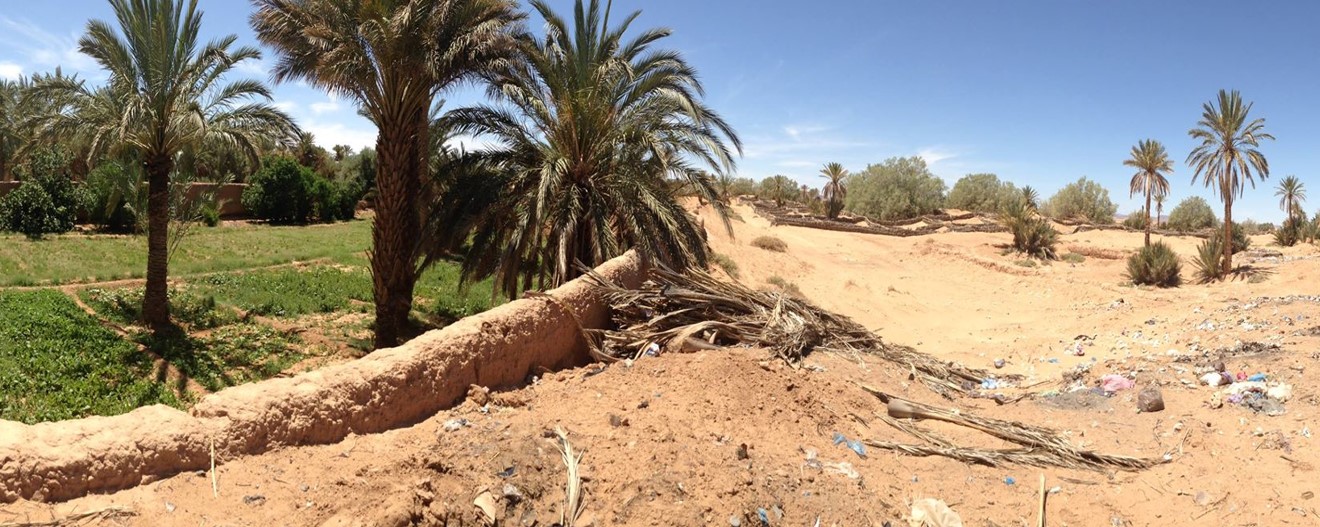Making Morocco’s oasis agro-ecosystems more productive and resilient

Fresh from hosting the COP22 climate talks – billed as the COP22 of action – the Government of Morocco signed an agreement with FAO in December 2016 for a new project to revitalize the oasis agro-ecosystems in the country’s Draâ-Tafilalet region.
The five-year project, known as OASIL, was co-financed by a grant from the Global Environment Facility (GEF) for over USD 9 million and by funding from national partners totaling over USD 40 million.
With FAO support, OASIL seeks to contribute to achieving global environmental benefits by lowering greenhouse gas emissions, reducing land degradation, improving water access and conserving the oases’ rich and globally significant agro-biodiversity. At the same time, the project aims to make the livelihoods of local oasis communities more resilient, and to explore new income opportunities.
Last line of defense
Morocco’s oasis agro-ecosystems cover about 15 percent of the country and are home to over 1.7 million people. These biodiversity hotspots provide important economic, ecological, social and cultural goods and services. They are also the last line of defense against an encroaching Sahara desert.
But various factors threaten their survival, including the abandonment of traditional cultivation and farming systems that have nurtured the ecosystems for centuries, increased pressure on land and water resources and growing urbanization.
Diversified income, resilient livelihoods
Using a sustainable and integrated landscape approach, OASIL aims to breathe new life into these once resilient agro-ecosystems.
The project will weigh the carrying capacity – that is, the number of people the land, water and biodiversity can support – in four pilot oasis ecosystems, and direct investments to address the specific environmental pressures and socio-economic needs.
People in the oases live largely from remittances, as men increasingly migrate to urban areas, either permanently or for seasonal work, leaving behind women and young people. OASIL will focus on diversifying income sources for local populations and strengthening rural livelihoods.
The project, for example, will promote green technologies and biodiversity-friendly practices to help farmers sustainably intensify production of traditional high-value crops such as durum wheat, lentils and fava beans, and local livestock breeds like the D’man sheep.
The oasis agro-ecosystems hold a lot of untapped potential, and many economic sectors, such as the food industry, tourism and handicrafts, are largely underdeveloped. OASIL seeks to change that by strengthening the value chains of various agricultural products and exploring new options, such as agro-ecotourism. Local communities in the pilot oases will drive the process, identifying their own management and investment plans.
During the project, some 60 000 hectares will also be brought under sustainable land management, with a focus on water management.
Political commitment
OASIL will support policy dialogue at national and regional level, and set up an interactive platform for researchers, the Government and local communities to access the latest data and knowledge, best practices, approaches and tools for sustainable and integrated oasis landscape management.
By drafting a “declaration on sustainable oases”, OASIL aims to galvanize political support among national stakeholders to protect and sustainably manage Morocco’s oasis agro-ecosystems. The idea was inspired by the approach taken to develop the country’s Law on Pastoralism.
Growing portfolio in Morocco
OASIL is part of a growing portfolio of oasis-specific projects supported by FAO and its partners in Morocco, including an innovative GEF-funded project for “Globally Important Agricultural Heritage Systems”, targeting five selected oasis systems in Morocco’s south and northeast, and a regional project involving Morocco, Tunisia and Mauritania.
